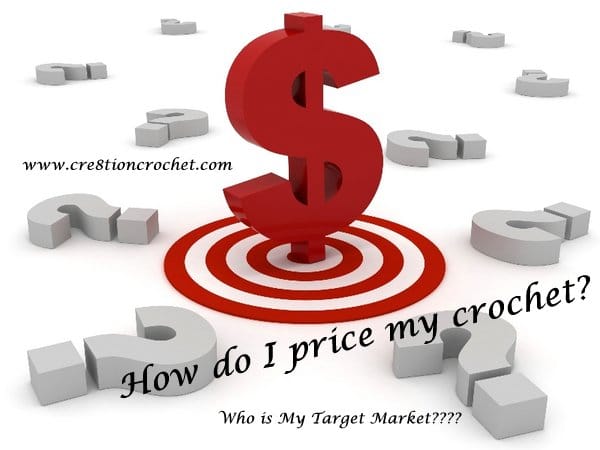Determining Price Point and Target Audience
The Selling Your Crochet series is designed for anyone who wants to start, or already owns, their own crochet business. Whether you are just starting out or need to improve sales for a business you already have, this is the guide for you. This series will be broken down into many parts. I will create actions steps for you to follow to help you start and grow your crochet business. If any information you are looking for hasn’t been covered or you need more clarification on any subject please comment below and I will be sure to answer any questions you may have.
Now that you have decided what you will make, you need to determine your price point. There are many, many things to consider when deciding where to price your finished work; target market, time and labor considerations, cost of materials, perceived value and more. Underpricing your work is harmful not only to you, but to all crochet and craft artists. We will also focus on some frequently asked questions about how to price handcrafted items. This article is a bit long because there is just so much to cover. In fact, there is much more, the specifics will go into detail in future articles in the series.
If you missed the first installment of the Selling Your Crochet Series….
start HERE with Part One- Deciding What to Make
Target Market is defined as: the intended group for which something is performed or marketed; the specific group to which advertising is directed
First and foremost, even before you take material and labor into account, you must first determine your target market. Knowing your target market will not only help you with deciding on how to price your work but it will also help you determine what materials to use and how much time you can comfortably spend on making your items. I am only going to briefly touch upon defining your target market because it has already been laid out in an easy and incredibly detailed format by Sedruoula Maruska of Yarn Obsession in her ebook “How to Find Your Target Market”.
You can get your copy at a special Cre8tion Crochet rate (see below for details). Conversely, I will go over one example with you so that you can see why this is so important to know. Take baby blankets for case in point. If your target market is going to be young middle class families, than you will not make very many sales if you price these items high. This target market will control what materials you can use for these baby blankets and what designs and patterns you will use. You would be best served using affordable yarns such as Redheart, Caron’s and the like and using simple, quick to work up, designs. This way you can price them affordably for your target market.
Now if your target market is affluent, high class, families than you can charge more. However you can’t JUST charge more. Just because this target market has more money does not mean they are going to pay more for the same thing you would sell to someone with less money. You need to also increase the value of the baby blankets. You can use more quality materials, such as handspun or high end yarns in lush fibers and you should make the designs more intricate and detailed. There are also other ways that you can set yourself apart from the sea of crochet vendors that will allow you to price higher; we will go over that in a future installment.
Next to take into consideration is time and labor and how it relates to materials. I have often heard of the 3x rule. This is the rule that states that you multiply your cost of materials by 3 to get your sale price. While this works well some of the time, this is not a reliable way of pricing your work. Let’s take that same blanket as an example. We’ll go with both target market choices with a couple different scenarios.
A- Younger, middle to lower class families
You have decided you are going to target the lower end of the market for baby blankets so you purchased 3 skeins of Caron’s Simply Soft (945 yards) for approximately $11. You are going to make a simple striped blanket in dc that will measure 36”x36”. Now we’ll estimate that this blanket will take you 5 hours to make (we will go over how to estimate how long something will take you to make further down). Ok now if you follow the 3x materials rule you will be charging $33 for this blanket. Sound good right, but why don’t we back up a minute. Out of that $33 you spent $11 on materials so that is a $22 profit for 5 hours of work. That comes to $4.40 an hour. I don’t know about you, but that isn’t adequate compensation for the hard work and skill I put into each of my pieces.
Now the other target market
B- More affluent, maybe older, families
You are going to make the same size blanket but you are going to do a more intricate looking design, maybe a simple cluster stitch (which for all intents and purposes takes you exactly the same amount of time to make). This time you purchase the same amount of yarn (945 yards) in luxury hand spun. I used my favorite spinner (Spinning Wheel Studio) as an example and priced her hand dyed wool, falkland wool at the total cost of $130 for the same amount of yarn. So now you would multiply the cost of materials by 3 and get $390. Subtract your materials and you will be profiting $260. Sounds great for 5 hours of work, I wish I could make $52 an hour. Let’s be realistic though, not many people are going to pay $390 for a 36”x36” baby blanket, though I’m sure there are some who would. But wait, didn’t this blanket take you the same amount of time to make as the first blanket that you made with Simply Soft and sold for $33? That doesn’t seem fair.
Now the upper class target market with a different blanket
C- This time you are going to use more expensive yarn but not quite as expensive as the handspun, (Sublime Cashmere Merino) for the same amount of yarn would cost $90. The pattern we are going to use here takes 8 hours to make (in the same size). Now again, multiply your materials by 3 for $270. Subtract out your materials for $180 profit. Since this blanket took you 8 hours to make you will earn $22.50 an hour. Still a great profit but it is also unlikely that you will find someone who will pay $270 for a small baby blanket.
If you made the same baby blanket using Caron’s Simply Soft and used the 3x material rule you would be charging only $33 for the same blanket giving you a profit of $2.75 an hour. How does that make any sort of sense. You did the same amount of work. Shouldn’t you make the same per hour no matter what?
This is why I never recommend the 3x material rule. It isn’t fair to you and it certainly isn’t fair to the consumer. The way I price ALL of my work is time plus materials. We will use the same three scenarios above using my method.
A- Baby blanket using Caron’s Simply Soft that took 5 hours to make
$12 an hour= $60
Materials= $11
Total cost $71
B- Baby blanket using handspun yarn that took 5 hours to make
$12 an hour= $60
Materials= $130
Total cost $190
C- Baby blanket using luxury boutique yarn that took 8 hours to make
$12 an hour= $96
Materials= $90
Total cost $186
Now those are reasonable prices for crochet blankets that fit nicely into the target audiences you are reaching for. You may find that the first blanket can be a little out of reach for some families so you can always consider lowering your per hour charges for large items which is what I do. Honestly, I would probably charge $10 an hour ($8 is the least amount that I ever charge) and sell the first blanket for around $61. I have a standard rate that I charge depending on the size of the project but I also price based on the uniqueness of an item and this is also where perceived value comes in. There is no right or wrong answer for how much you should charge per hour but I recommend taking two things into consideration, what your hourly rate of pay would be if you were working a standard job and your target audience’s paycheck. I know if I were going to get a job somewhere that I would not accept under $15 an hour. Anything less isn’t worth taking time away from my family. When I was less experienced at what I do I would accept $8-10 an hour to start. Crochet is a skill, it cannot be compared to a minimum wage job.
Granted I love what I do so I do accept less than $15 an hour in order to indulge in my passion. I end up charging somewhere between $8-12 an hour (for large projects) and $15-20 for smaller projects (hats, jewelry) etc. The reason I used $12 an hour in my above examples is because it is a range right in the middle and a good place to start when deciding what you should charge per hour. Then take your target market into consideration. Someone who only makes minimum wage may not be able to afford to pay you $12 an hour and maybe you should average $8-10 an hour. The more affluent people can afford to pay more so you can charge higher, maybe $15 an hour. Next I’m going to discuss perceived value in more detail to help you determine what to charge per hour based on your projects.
Perceived value is defined as: The worth that a product or service has in the mind of the consumer. The consumer’s perceived value of a good or service affects the price that he or she is willing to pay for it. For the most part, consumers are unaware of the true cost of production for the products they buy.
People purchasing crochet usually have NO idea of what the value of these items should be. If they did than that means they could probably crochet themselves and would be able to make it. I am going to use a different example here.
I’m going to use a women’s adult hat as an example. I’ll use the same exact yarn examples as above. The average yardage f yarn for a women’s hat is approximately 230 yards. The cost breakdowns for each would be $3.50, $38, $24, (I’m calculating this price per skein/hank that you will need, each example will have a small amount of left-over). Women’s adult hats take an average of 45mins to 1.5 hours. But we’ll use 1hour as the standard here. Below you will see a chart that describes the different ways to price this hat including materials.
Now take a look at that chart and see if you can spot the imbalances. The hats all took one hour to make. But using the 3x material rule you can see how out of whack the prices will get. Example B should not cost almost 100% more just because it’s more expensive materials. You must charge for the materials but you must be fair as well, or no one will purchase from you. My basic women’s hats made with lower end yarn (Caron’s, Redheart, etc) are sold at $18-24 depending on how long they take me to make and the intricateness of the pattern. Like I said earlier, I charge the higher end of my price per hour rate for smaller projects and that is why. A women’s hat is worth more than $10.50 (using the 3x material rule) and worth more than $13.50 (using a $10 per hour rule). It is DEFINTLEY worth much more than $10.75 which would be the cost if you calculated materials plus national hourly minimum wage.
You must remember that you are using a learned skill. You were not given this talent without any hard work involved. And what about the fact that you have to go to the store and buy the yarn, and the time spent researching a pattern, or even designing a pattern. I charge slightly higher on the scope because I design all of my own designs, I don’t use patterns. But even if you do use someone else’s pattern you still had to take the time to read and follow or learn the said pattern. You also have to spend time and/or money to advertise your work. That needs to be thought of when deciding your price per hour.
Take your emotions out of it. Price should not be based on fear or guilt. These are the things that tend to hold handcrafted vendors back the most. In the next article we will be discussing how to beat the fear and guilt that comes along with selling. How to have confidence in what you do and how to add extra value (both real and perceived) to your work.
But in the meantime, I can tell you one thing from experience, people think higher price means better quality. They assume if you are selling cheaply than your work must not be very good. I have seen people who were extremely talented who can’t make sales while someone else with only mediocre work selling their items at ridiculously high prices for what they were selling, and still making the money. When you sell low you hurt everyone. You make less money than you deserve and you damage the craft as a whole, causing other vendors to sell for less to stay competitive. If everyone sells on the same playing field than it is fair to everyone. Believe me, someone out there wants what you are selling, you just have to find them. We will be discussing advertising, marketing and finding your customer base in a future article. We will also discuss shipping- including shipping in payment vs having customer pay for shipping.
Homework for the week
Your homework for this week is to take a long, hard and honest look at how you price your work. Are you undervaluing yourself and your craft? Are you basing your pricing on fear or doubt? Think about why you charge less than you know you deserve and write it down. I will be asking you for your input so that I can help you and others with the fear and doubt that often hold us back.
I also want you to determine what your hourly rate range will be. You are NOT allowed to charge less than national hourly minimum rate. Think about who you want your target audience to be, or who they already are.
Next week I will teach you how to feel good about that price and what you can do to add value to your work!
Added Tip
At some point somebody is going to ask you how much it will be for you to make something that you have never made before. First, do NOT give them an answer right away. Tell them you need to calculate the costs. You can even ask them details to help you decide your cost (what colors, what size, what design, etc).
Take that information and come up with an estimate, not an exact cost. I also recommend, HIGHLY, that you get the costs for materials up front before you take on the project. Especially if it is a custom order that will not be easily sold if they back out.
You should always know how much your materials will cost. To do this you should calculate a test swatch in the materials you use and in the stitches you use most often. Measure how much yardage it takes for a certain size and then use that to gauge how much materials you will need for each product.
Lastly I asked my followers what problems they had when decided prices made those inquiries into a FAQ’s list. If you would like to see anything added please feel free to comment below and your question may make it into the list or into a future article.
FAQ
What about pricing low when you first start?
Be careful of how much lower you price yourself when you are new to the craft. While it is true that those with more experience can charge higher prices, experience isn’t the only thing to go by. Some “newbies” produce more quality work than some veterans. If your work is clean, neat and free from errors you can charge the same as someone who has been selling for years. If you do decide to sell slightly lower because you are new or you feel your work isn’t up to par just yet than only sell for a few dollars less than you want to eventually end up. It is hard to raise your prices once you build a market. When you do get better make sure your prices reflect that. Start by charging a dollar or two more an hour to begin.
Other people are selling for much less how will I compete?
First off, you are not competing. You are your own unique self and so is your work. Produce quality, well made items. Put the extra effort into packaging, marketing, etc. Use quality product. These topics will be touched upon more in the next article. Standing Out in the Crowd. How to Get New and Repeat Business.
Does it matter if this is your hobby or your career?
I am changing my answer here, but I am going to leave my initial answer as well. There is a difference IF you are doing it only as a hobby and not as a business. It is different if the person whom you are “selling” it to knows that they are ONLY paying for material (or even a tiny bit more for your time). Selling it “cheap” without the consumer knowing, puts in their head that crochet work comes cheap. Making them think it isn’t worth much and thereby devaluing the art in whole. This hurts people who sell crochet and handcrafted items for a living. If you want to give your work away or only cover the cost of yarn, please let the consumer know that, tell them you do this as a hobby and just want to share your work. That way you are not hurting the craft or the craft vendors at all!
No, it does not matter one bit. Whether you crochet every day or make one new item a week has no influence on what you charge. If you do this for a living you may charge more based on your experience and skills but that would not be the only contributing factor. Any time you spend making an item for sale must be reimbursed fairly.
If you choose to crochet because you like it and are not interested in making money I recommend giving your work away as a gift, or if someone requests an item, charging them only the cost of materials. Be sure they know that you are only charging materials because you are not interested in making a living from your craft. Just make sure they do not believe it is because you don’t think your skills are worth paying for. Don’t cheapen the craft as a whole buy under valuing the work involved.
What if a potential customer tells me they can get the same thing cheaper somewhere else?
Very nicely and respectively tell them they can certainly purchase that item somewhere else then. Explain that you sell only quality work and that you know the value of your product and will not sell it for less than it’s worth. More than likely they will come back and buy from you in the future. If you don’t have confidence in your work than no one else will either. Just remember to always be respectful and honest.
Special Offer from
Yarn Obsession
Get the ebook “How to Find Your Target Market” at the introductory low price of $3.99. This offer is only available using this link. The full price is $5.99
Here’s what you’ll learn:
Why you need to know your target market
Who you and your product / service are
How to evaluate your target market demographic profile
How to evaluate your target market values and lifestyle
How to determine how your audience uses your product / service
How to create a prototype
Yarn Obsession also has a very good ebook on pricing. If you contact Sedruoula on the Yarn Obsession facebook page she will give you a special rate on this ebook as well. Use the the phrase “Pricing from Cre8tion Crochet” She will send you an invoice for the book at a 25% discounted price of $5.98!
I hope you learned something and enjoyed reading this article on how to price your crochet. If you ever have any questions or need help pricing an item please feel free to contact me. You can reach me by email at [email protected], on the Cre8tion Crochet facebook page, or you can leave a comment below.
If you found this helpful, please share it. Pricing fairly affects everyone, in every craft. Lets make the change!
Have fun and as always…
happy hookin’
Part Three- How to Get the Prices You Deserve- Don’t Let Guilt and Fear Hold You Back









